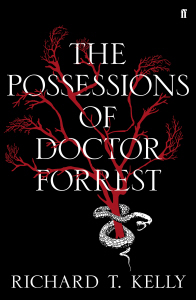 There’s something that gladdens the heart – or, if you like, sets rich red blood coursing through one’s quivering veins – to note the recent resurrection of the Hammer Films brand. I doubt I’ve sat and re-watched a vintage Hammer production since I was a boy; but back then, oh for sure, they were a notable source of rather exquisite chills – my awareness of the Hammer name helped in no small part by the then-running ITV series Hammer House of Horror, which was vividly gruesome, occasionally racy, and always a talk-about show in the school playground (at least for those kids who could get round their parents’ viewing strictures to that degree.)
There’s something that gladdens the heart – or, if you like, sets rich red blood coursing through one’s quivering veins – to note the recent resurrection of the Hammer Films brand. I doubt I’ve sat and re-watched a vintage Hammer production since I was a boy; but back then, oh for sure, they were a notable source of rather exquisite chills – my awareness of the Hammer name helped in no small part by the then-running ITV series Hammer House of Horror, which was vividly gruesome, occasionally racy, and always a talk-about show in the school playground (at least for those kids who could get round their parents’ viewing strictures to that degree.)
The love shown toward old Hammer productions tends to be more of this nostalgic/genre-based fondness than high-minded critical acclaim (though there’s been a fair bit said in favour of such 1960s entries as The Gorgon and Quatermass and the Pit.) But let’s not be too picky. For me the most vivid, memorable Hammers are those of the early 1970s, when the studio was generally reckoned to be trying to add ‘adult’, gory and risqué flavours from American and European film into their usual stew. Hence the unabashed come-on elements of the trilogy of films fashioned from Sheridan Le Fanu’s Carmilla: the first being The Vampire Lovers (1970), shameless in a way, yet a deathless testament to the presence of the late Ingrid Pitt, whose life story was eminently more extraordinary than any supernatural tale. Lust for a Vampire (1971) was more brazen yet, and the poorer without Pitt, but I think you have to say there is something weirdly compelling about the extraordinary Masoch-istic zeal of Ralph Bates in this clip. Hammer had quite a knack, I think, for making their female villains into half-plaintive, half-scarily-regnant figures, as with the Amazonian Valerie Leon in the Bram Stoker-derived Bloody From The Mummy’s Tomb (1971.)
Vampire Circus (1972) was another lively twist on the vampire legend, which I remember as really strange and bold, not least in its extravagant menacing of little children. Brian Clemens, he of TV’s The Avengers and The Professionals, contributed two half-successful Hammers. First, Dr Jekyll and Sister Hyde (1971), a ‘transgendering’ of Stevenson that is stylish in places but mainly, like so many films of that book, bogged down by Jack-the-Ripper-like murders. And then Captain Kronos Vampire Hunter (1974), a spookily atmospheric oddity that, I understand, is due a remake. I’m not sure how well the filming of Dennis Wheatley’s To the Devil a Daughter (1975) would stand up now; but I will think of it fondly as the picture that introduced Nastassja Kinski to English-language cinema.
And then shall we speak of the Count? I’ve half a notion that the first in the long stream of Hammer Draculas I actually saw was The Satanic Rites of Dracula (1973), in which Christopher Lee lurks in the shadows of contemporary London, a reclusive property developer plotting to destroy the global population by means of a lethal virus. Perhaps I owe to this movie (to these credits) the spark of my interest in dragging the gothic right up to date in a London setting…? This clip, for all that the blocking and timing are laboured, has a nice feel and reminds one why Lee made such a commanding Count, however much he came to disdain the role.
But I daresay in critical terms the quintessential Hammer will always be their first Dracula (1958) by Terence Fisher, not least because Martin Scorsese has been such an outspoken fan of its rich reds and blacks. By the time of its fiftieth anniversary it was sufficiently august for the BFI to re-release it, and construct this splendid trailer that puts an elegant frame around its enduring – undead – charms.
Tag Archives: hammer house of horror
39. To Hammer Horror, With Love
Filed under Uncategorized


